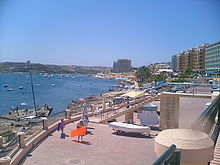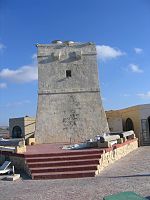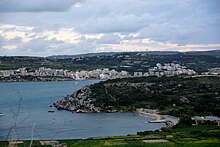 | ||
| San Pawl il-Baħar, St. Paul's Bay (Buġibba, Qawra) | ||
| District | Northern District | |
|---|---|---|
| Residents | 21.046 (2014) | |
| height | 0 m | |
| no tourist info on Wikidata: | ||
| location | ||
| ||
San Pawl il-Baħar is a community in Northern District on the island Malta. The city includes next to the district of the old fishing village San Pawl il-Baħar also Bugibba, Qawra and other hamlets.
background
The city developed around the old fishing village San Pawl il-Baħar at St. Paul's Bay in the northeast of Malta. To the community resp. the local council mainly owns the tourist stronghold Bugibba (approx. 7,500 inhabitants, several times as many hotel guests in the season), the one on the hill Qawra (approx. 2,000 inhabitants, many luxury homes), the one on the road to Mellieħa located street village Xemxija (1,000 inhabitants) and other settlements.
The place has developed into one of the tourist strongholds of Malta with numerous hotels, apartments, restaurants and bars, here you can find beach life and at the same time good transport links to explore the rest of the island.
Also the island off the Mellieħa range of hills St. Paul's Island belongs to the municipality.
history
Neolithic shaft graves excavated in Xemxija and the cart ruts that can also be found in the municipality bear witness to the settlement in prehistoric times.
With the beginning of Roman rule in 218 BC. St. Paul's Bay became one of the busiest ports on the island of Malta. Remnants of a Roman road in Xemxija bear witness to this era.
Under Roman rule there was an event that shaped the history of the island. With the shipwreck of the ship on which the apostle Paul is for questioning Rome should have been transferred, before entering the bay, Christianity was brought to Malta.
According to legend, the shipwreck occurred on the island St. Paul's Island, Paul and his companions are said to have saved themselves by swimming on the shore, at the place where they are said to have entered the mainland, the St. Paul's Shipwreck Chapel built. After the occupation of the island by the Arabs and the time when the pirates made the seas unsafe and corsairs tried to capture and enslave residents, the area was largely depopulated for several centuries, apart from a few fishermen and farmers.
This changed with the arrival of the Order of St. John on the island in 1530, when the coastlines were secured by the construction of watchtowers and fortresses and the fleet gained maritime sovereignty. The cities grew in size until the French fleet arrived on June 10, 1798 Mellieħa and anchored in St. Paul's Bay. Due to the exploitation of the country to finance Napoleon's Egyptian campaign, Malta's residents called on the British for help and were able to get rid of the unloved French masters.
Under British rule there was brisk construction activity around St. Paul's Bay, many of the buildings were requisitioned as essential to the war effort in the Second World War. With the end of the siege of the island of Malta in 1943, seventy-six ships of the Italian fleet surrendered. In the seventies and eighties, with massive construction activity, Bu entwickelteibba in particular developed into a tourist stronghold, the "English Mallorca".
getting there
By plane
Most travelers arrive in Malta by plane, from Malta International Airport in Luqa can be reached by bus to the localities in the north of Malta.
By bus
The express line X1 runs from the airport Luqa via the transfer station from Marsa along the east coast past St. Paul's Bay (without Buġibba!) further on Mellieħa and after Ċirkewwa to the ferry port of the car ferry Gozo.
The express line X3 runs from the transfer station in Marsa above Rabat to St. Paul's Bay and further after Bugibba and Qawra (where many hotels are).
The bus route 31 wrong from Valletta above Naxxar and Mosta continue after St. Paul's Bay (with Buġibba and Qawra). The bus route 12 wrong from Valletta along the east coast over Sliema and St. Julian's continue after St. Paul's Bay (and also makes the rounds of the peninsula with Buġibba and Qawra).
The line 223 runs between St. Paul's Bay and the Golden Bay resp. Għajn Tuffieħa Bay.
By train
There have been no rail links on Malta since 1931.
In the street
From the open plan Valetta can be reached on the main road 1 along the east coast which past San Pawl il-Baħar (St. Paul's Bay) after Mellieħa and on to the ferry port of Ċirkewwa leads.
By boat
In St. Paul's Bay lay excursion boats St. Paul's Island and Comino on, the passenger and car ferry to Gozo but puts in Ċirkewwa from.
mobility
Locally one moves on foot, in order to reach the way from the stop St. Paul's Bay to the hotel in Buġibba or Qawra, one can also use one of the bus lines that go around the peninsula.
Tourist Attractions
St. Paul's Bay / San Pawl il-Baħar


- the 1 St. Paul's Bay Parish Church Mater Dolorosa was elevated to a parish church in 1905. It was built from 1900 according to plans by Emmanuel Luigi Galizia thanks to financial support from Anna Bugeja, as St. Paul's Shipwreck Chapel was no longer able to meet the number of believers in the growing town. Stained glass windows and paintings by the Maltese artist Giuseppe Calí are well worth seeing.
- the 2 Lady of Mount Carmel Church was built in 1854/55 and enlarged in 1927 thanks to financial support from Marchioness Anna Bugeja.
- the 3 Chapel of St Paul’s Shipwreck stands at the point where the apostle Paul and his companions are said to have reached the shore after the shipwreck and lit a fire, where he was bitten by a snake and survived this without damage. According to legend, a church stood here as early as the first century AD, at any rate after the reconquest of Malta by the Norman king Roger I in 1090 a church was built here again. Around 1600 the old chapel had to give way due to the construction of the fortress and Grand Master Wignacourt built the church at its present location around 1600. During the Second World War, the church took a direct hit and was rebuilt in 1950.
- the 4 Wignacourt Tower was built as one of the first fortifications in the country in 1610 according to plans by Vittorio Cassar under Grand Master Alof de Wignacourt, the tower was renovated around 1973/76 and has housed the Island Fortress Exhibition with a collection of contemporary weapons and equipment since 1998.
- the 5 Simar Nature Reserve was established as a bird sanctuary by Bird Life Malta around 1990 and is a popular breeding area with its freshwater pools.
Bugibba
- the promenade with the 1 Perched Beach, a 150 m long bathing beach artificially piled up on rocky ground
- the 6 Dolmen in Buggibba was included in the construction of the Dolmen Resort Hotel.
Qawra


- the parish church 7 Parish Church of St Francis of Assisi was built as a modern building according to plans by the Maltese architect Richard England around 1993.
- the 8 Qawra Tower was built in the area of Cape Ras il-Qawra (Qawra Point) under Grand Master Juan de Lascaris-Castellar and, together with the Għallis Tower, served as a warning system as part of a chain of towers along the island's coast. Around 1715, the tower was expanded to include an artillery position, and today there is a restaurant in its semicircular walls.
- 9 The Malta Classic Car Collection, Klamari Street, Qawra. Tel.: 356 21578885, Email: [email protected]. It was opened in 2004, building on the Carol Galea car collection, and more than 80 motor vehicles are exhibited on around 3,000 m².Open: Mon-Fri 9 am-6pm, Sat 9 am-1pm.
St. Paul's Island
- The island (or in fact two islands connected by a narrow rock bridge) is in front of the place. A big 10 Paul statue was built in 1844 as the work of Segismondo and Salvatore Dimech and visited by Pope John Paul during his visit by boat.
- The island can be reached with a (rented) boat or, if necessary, for experienced swimmers from the bay below Fort Campbell, the landing stage is in the south on the isthmus between the two parts of the island.
- northeast of the island are the wrecks of the ferry "Imperial Eagle" sunk as a diving destination and the submarine "HMS Stubborn" as diving destinations.
Xemxija
- the 11 Church of St. Joseph the Worker / San Ġiużepp Haddiem was built to replace a Capuchin chapel from 1935 and had to be redimensioned by 1993/94 due to structural defects. From the terrace there is a beautiful panoramic view of St. Paul's Bay.
- prehistoric ones can be found north of the settlement 12 Cart tracks (so-called "Cart Ruts"), the origin and purpose of which are still in the dark.
- Neolithic shaft graves can also be found in the north of Xemxija. A Heritage Walk was set up, which leads past the ancient sites.
- the bay 13 Mistra Bay on the north side of St. Paul's Bay can be reached on foot or by car.
- the 14 Mistra Battery with a semicircular artillery platform at the entrance to St. Paul's Bay was built in 1761 under Grand Master Pinto da Fonseca.
Wardija
- at 15 St. John the Baptist Chapel, The chapel was built in the area of an older chapel in 1610 by Jerome Xerri from Naxxar and renovated in 1852 by Count Sciberras Bologna. There are other family chapels in the area.
- the chapel 16 Our Lady of Grace or Our Lady of the Abandoned was built in 1690 by the later grand master Ramon Perellos de Rocaful. After it was destroyed by Napoleonic troops, the Manduca family renewed the chapel.
- the 17 18 Busewdien Cart Ruts on the street Triq Busewdien.
St. Martin
- 19 St. Martin's Chapel: the chapel was rebuilt in 1666 on the foundations of a building first documented in 1466, the round window above the portal and the small bell tower with a bell, which shows a Madonna and the face of Christ on the other side, are striking.
- nearby is that St. Martin’s Grotto, The natural cave was probably used as a burial place and later as a storage room as early as the Punic-Roman period. In 1931 the grotto was embellished into a Lourdes grotto and today a nativity scene is exhibited during Advent.
Burmar wheel
- the 20 Parish Church of the Immaculate Heart of Mary in Burmarrad is a modern building from the years 1958/61 and was consecrated as a parish church in 1971.
- in the area of the chapel 21 Chapel of San Pawl Milqi Legend has it that the Roman governor Publius had his country estate where the apostle Paul is said to have healed his father - however, in the area of the church built in 1616/22, ruins of a country estate with wine and oil presses were discovered during excavations.
- the chapel 22 St Margaret’s Chapel in Ghajn Rihana dates from the 17th century, the front half with the enlargement of the church interior from 1849, the bell dates from 1708.
- the 23 Kappella ta 'San Mikiel Arkanġlu(Chapel of St. Michael Archangel) in Salina / Burmarrad was built in 1652 on older foundations.
- nearby are the very sparse remains of the 24 megalithic temple of Tal-Qadi.
Salina Bay

- the coast on the 1 Salina Bay is rocky, but due to the proximity of the tourist centers, many people meet here for swimming and snorkeling. On the southern bank there is a system of salt pans that have been used for salt production since ancient times.
- the 25 Għallis Tower across from the other end Salina Bay at Ras il-Ghallis (Ghallis Point) was built in 1658/59 as part of the network of warning towers of the De Redin Towers built.
activities

- Swimming and water sports, including at the artificially raised one Perched Beach and Bugibba.
- Diving to shipwrecks lying off the coast at Qawra Point, for the more water-shy travelers Captain Morgan Cruises offers "Underwater Safaris" with a special glass bottom boat.
- Hike from Xemxija along the coast and past the Mistra Bay and Ghajn Hadid Tower to Mellieha (approx. 2 hours).
shop
In Bugibba and Qawra there are various mini markets as well as bakeries and butchers.
- Scott's Super Market, at the north end of Burmarrad. The Market offers the largest self-catering range in the northwest of Malta.
kitchen
Numerous restaurants from inexpensive to upscale can be found in Bugibba and Qawra, with the latter being more upscale.
nightlife
Regarding nightlife are Bugibba / Qawra after St. Julian's the second destination in Malta. In Bugibba it's more like Mallorca - moderate to and fro (focus around Triq il-Kahli and along the beach promenade between the jetty and the Il-Baija Platz), in Qawra a bit more upscale (mainly east of the bus station, around Triq it-Turisti and Triq it-Tamar).
accommodation
In Bugibba there are numerous hotels, from inexpensive backpacker hotels to upper class, the hotels in Qawra are often a bit higher priced and are also booked by package customers.
In Xemxija there are some inexpensive accommodations, other hotels had to close because the distance to the promenade in Bugibba is too great for many.
health
Practical advice
- St. Paul's Bay Local Council, St. Paul's Street, St. Paul SPB 3411. Tel.: 356 21585888, Fax: 356 21583058, Email: [email protected].
trips
- by public transport (i.e. bus) is the Cirkewwa Ferry Terminal for visiting Gozo easy to reach.
literature
Web links
- http://sanpawllocalcouncil.com/ - Official website of San Pawl il-Baħar

